Scottish Study of Early Learning and Childcare: ELC Leavers (Phase 2) Report - Updated 2021
Findings from the second phase of the Scottish Study of Early Learning and Childcare (SSELC), a research project established to evaluate the expansion of early learning and childcare (ELC) in Scotland.
This document is part of a collection
Child health and development
Assessments of development
Children's keyworkers at ELC settings were asked to complete observations of the child's development using the Ages and Stages (ASQ) and Strengths and Difficulties (SDQ) questionnaires. Both the ASQ and SDQ are widely used by Health Visitors across Scotland as part of their health reviews of pre-school children – the Scottish Child Health Programme[28]. These particular instruments were also selected for inclusion in the Child Health Programme following an extensive review by academics and practitioners[29].
The ASQ provides a structured assessment of a range of developmental domains, usually using a parental questionnaire supported by observation of the child at play, to identify children at increased risk of developmental difficulties. There are 30 items split into five different domains: communication, gross motor, fine motor, problem solving and personal-social. By answering 'yes', 'sometimes' or 'no', the respondent indicates whether or not the child can complete the action or provide the response required. Each domain produces a summary score which can be used to indicate whether the child's development is on schedule, needs monitoring or requires further assessment. Whilst it is designed to be completed by parents, because it is informed by observation of the child it was deemed suitable for completion by the child's keyworker at their ELC setting.
The SDQ is a commonly used behavioural screening questionnaire designed for use with children aged between three and 16. It consists of 25 questions about a child's behaviour to which the respondent can answer 'not true', 'somewhat true' or 'certainly true'. Responses can be combined to form five different measures of the child's development, namely emotional symptoms (e.g. excessive worrying), conduct problems (e.g. often fighting with other children), hyperactivity / inattention (for example, constantly fidgeting), peer relationship problems (e.g. not having close friends), and prosocial behaviour (e.g. being kind to others). Furthermore, the first four measures can be combined into a 'total difficulties' scale. Higher scores imply greater evidence of difficulties on each of the scales, with the exception of the prosocial behaviour scale where the reverse is true. In this report, recommended banded versions of the scales have been used to create the following categories: 'close to average', 'slightly raised', 'high' and 'very high', with 'very high' indicating multiple difficulties identified.
Ages and Stages Questionnaire
Figure 7 provides a breakdown of the proportion of children whose development was regarded as requiring further assessment, monitoring or as being on schedule across the five ASQ domains. The majority of children were considered to be on schedule on all domains, as may be expected for a nationally representative sample. The proportion of children considered to be on schedule was highest in the personal-social domain (93%), followed by the problems solving domain (89%) and the communication domain (88%), and lowest in the gross and fine motor domains (81% and 82% respectively).
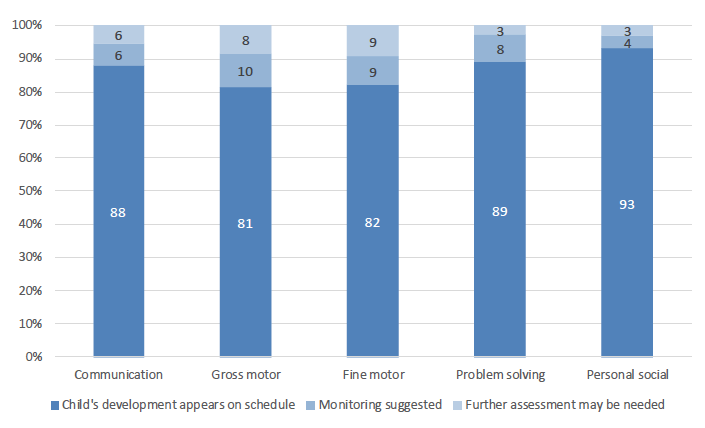
Base: All children (keyworker observations, weighted)
Differences in ASQ scores by gender, socio-economic status and SDQ scores
As is commonly seen on a range of different measures throughout childhood[30], girls were more likely than boys to be on schedule on all the domains, although the large majority of boys as well as girls were on schedule in each case. On three of the domains (communication, fine motor and problem solving), there were associations between area deprivation and not being on schedule, and between low income and not being on schedule. On the gross motor, fine motor and problem solving domains there were also associations between low levels of education and not being on schedule. Scores on the personal-social domain were not associated with any of these measures of socio-economic status. Further details of these associations are provided in the following sections.
It is worth noting that socio-economic factors tend to be associated with each other: those with low levels of education are more likely to be on lower incomes and to live in more deprived areas. Certain risk or protective factors also tend to be more prevalent in different socio-economic groups. For example, breastfeeding and high frequencies of home learning activities are both associated with high levels of parental education. The differences observed in the following sections looking at socio-economic factors should therefore be viewed in light of the other figures discussed later looking at the child's home environment. Any difference seen between sub-groups is not necessarily due to the particular factor being considered, but could be due to a combination of factors. In addition, in some cases there may be no causal association at all between a specific risk factor and the ASQ scores, with the association due entirely to other known or unknown factors. Towards the end of the section on child outcomes we will look at regression analysis to determine the main drivers behind the observed associations.
There were also very strong correlations between ASQ and SDQ scores. While both measure child development, they do measure different things. The SDQ is concentrated on social, emotional and behavioural development, while the ASQ is more broad in its coverage of developmental milestones. There are many children picked up by one of the measures as potentially exhibiting development that is behind schedule, but not assessed as at risk on other measures. At the same time there are many children whose development is behind schedule in multiple different ways.
ASQ communication domain
Figure 8 breaks down scores on the ASQ communication domain by the sex of the child, the child's SDQ score and by area deprivation (SIMD). Girls were more likely to be on schedule (90%) than boys (86%), although the difference for the communication domain is not as large for some of the other domains. Children living in the most deprived areas were less likely to be on schedule (85%) than children living in other areas (89%). Children from wealthier families were also more likely to be assessed as on schedule than those from less wealthy households (94% of those in the top two income groups, compared with 84-86% of those in lower income groups) (see Appendix Table C6). No significant differences were noted by education or by number of parents.
As was the case with the other ASQ domains, a child's score on the communication domain was correlated with their SDQ total difficulties score. Those who had a SDQ score that was close to average were much more likely to be on schedule in the ASQ communication domain (92%) than those who scored 'very high' on the SDQ total difficulties scale (57%).
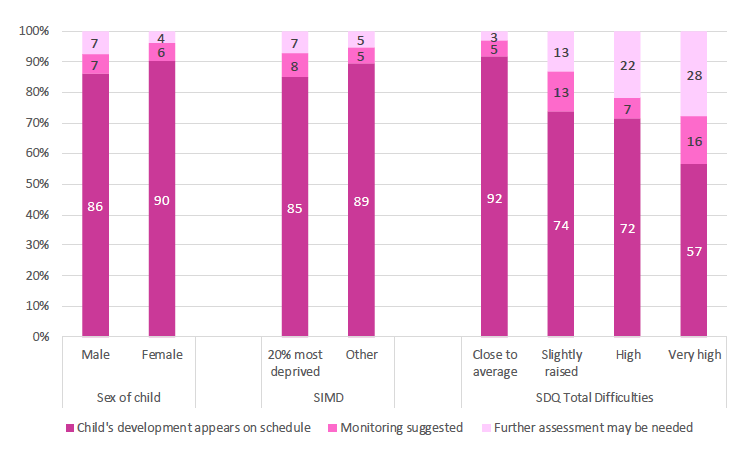
Base: All children (keyworker observations, weighted)
ASQ gross motor domain
Figure 9 provides a breakdown of the assessments in the gross motor domain by sex of the child and their SDQ total difficulties score. As was the case across all ASQ domains, boys were more likely to be assessed as requiring further assessment or monitoring than girls. Development was assessed as being on schedule for 87% of girls compared with 76% of boys. Those who scored close to average on the SDQ total difficulties score were also more likely to be on schedule in the ASQ gross motor domain than those who scored 'very high' (86% compared with 46%). There were no significant differences in gross motor scores by area deprivation or by number of parents, although there were differences by highest level of parental education. Where the respondent (generally the mother) had at least Highers or equivalent upper school or post-school qualifications, the child was more likely to be on schedule (82-85%) than where the respondent only had lower school qualifications (such as Standard Grades or equivalent) or no qualifications (72-74%). (See Table C7 in Appendix C).
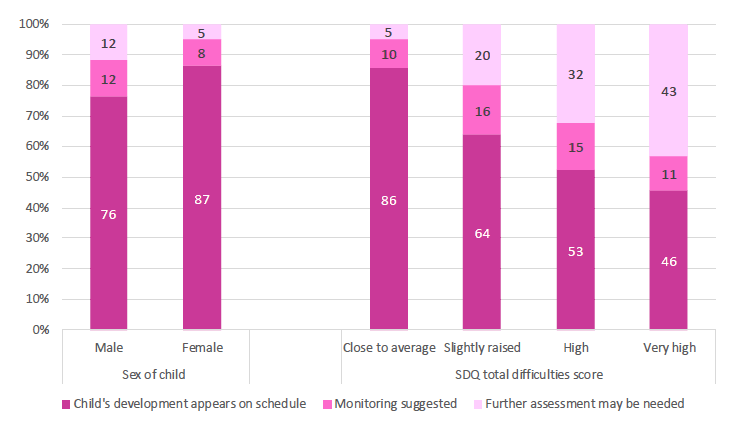
Base: All children (keyworker observations, weighted)
ASQ fine motor domain
Some of the largest differences between subgroups were evident in the ASQ fine motor domain. The gap between boys and girls as shown in Figure 10 was highest in this domain, with 92% of girls being assessed as on schedule for fine motor skills, compared with 73% of boys. Children living in the most deprived areas were less likely to be on schedule (76%) than those living elsewhere (85%), and children who were close to average on the SDQ total difficulties score were much more likely (86%) to be on schedule than those who scored 'very high' (41%).
The child's score on the ASQ fine motor domain was also associated with all of the other socio-economic characteristics examined, as shown in Tables C8 to C10 in Appendix C. Higher household income and higher levels of parental educational attainment were both associated with increased likelihood of a child being assessed as on schedule for fine motor development, as was living in a two parent household (compared with a single parent household).
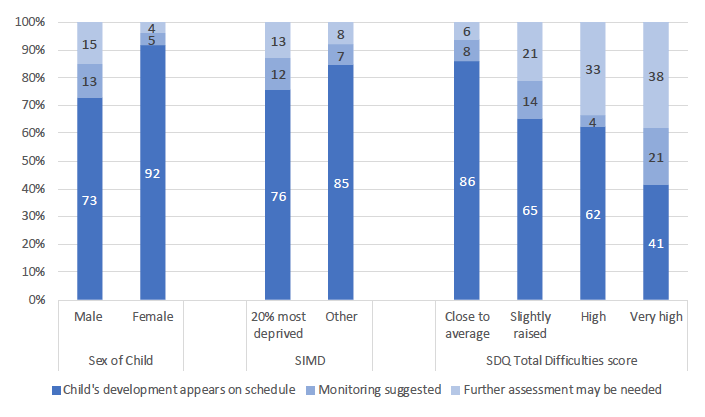
Base: All children (keyworker observations, weighted)
ASQ problem solving domain
For the ASQ problem solving domain a number of associations with socio-demographic factors were again evident. Girls were more likely than boys to be on schedule (93% compared with 85%). Those in the most deprived areas (84%) were less likely to be on schedule than those residing in other areas (91%). Figure 11 also illustrates the strong association between the ASQ problem solving domain and the SDQ total difficulties score, with 92% of those with a close to average SDQ total difficulties score assessed as on schedule for problem solving, compared with 64% of those who scored 'very high'. The appendix tables reveal further associations between household and socio-economic factors and increased likelihood of being on schedule for problem solving, including living in a high-income household (Table C11), having parents with at least Highers or equivalent (Table C12) and living in a two-parent household (Table C13).
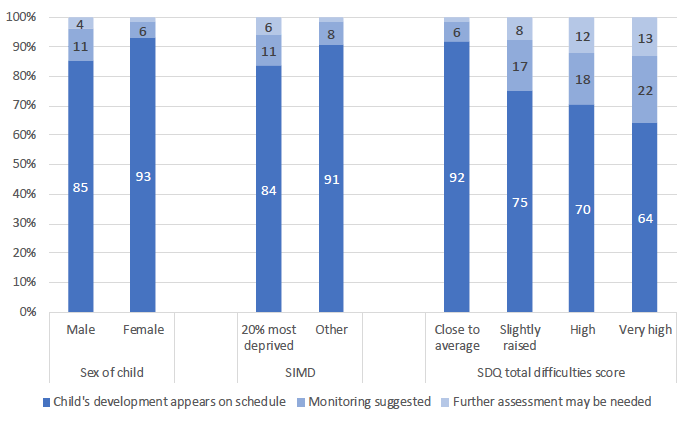
Base: All children (keyworker observations, weighted)
ASQ personal-social domain
Finally, Figure 12 breaks down the ASQ personal-social domain by sex and SDQ total difficulties score. Girls (96%) were more likely to be on schedule than boys (90%) and those with close to average SDQ scores (97%) were more likely than those with 'very high' scores (59%) to be on schedule. Socio-economic status did not appear to be associated with scores on the ASQ personal-social domain.
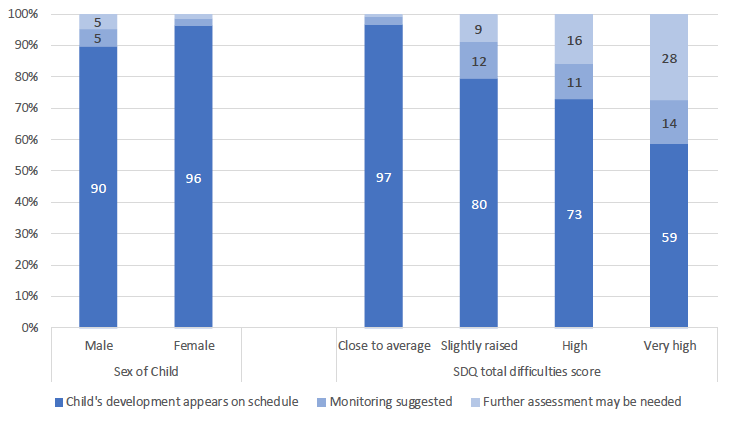
Base: All children (keyworker observations, weighted)
Strengths and Difficulties Questionnaire
Figure 13 provides a breakdown for all five of the SDQ domains as well as the total difficulties score. The prosocial behaviour domain is coloured differently to highlight the different labelling, although the general meaning of the categories are similar. The scales are designed so that most children have a score in the 'close to average' range, with around 20% of the population having raised scores (lowered for prosocial behaviour), although some variation is expected according to the age of the children. Data from the keyworker observations shows that for each of the domains, proportions of children with raised scores are as expected from a nationally representative sample with 85% of children scoring close to average in their SDQ total difficulties score (the sum of the scores for the four "problem" domains). The domain in which the most children scored close to average was prosocial behaviour (92%), followed by conduct problems (89%) and peer problems (86%). The domains in which the lowest proportion of children scored close to average were hyperactivity (78%) and emotional symptoms (80%).
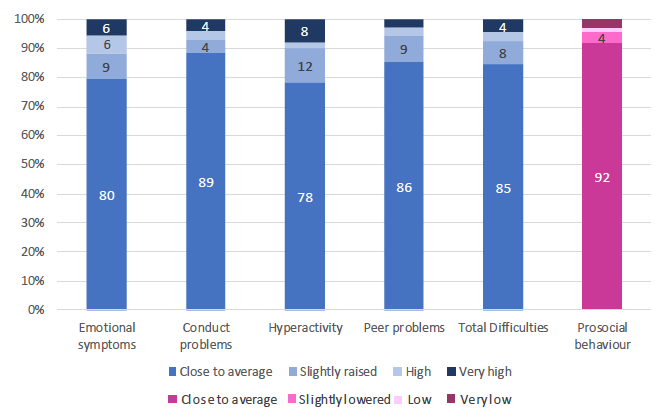
Base: All children (keyworker observations, weighted)
Differences in SDQ scores by child's sex and SIMD
As seen with the ASQ scores, the child's sex was a significant factor in predicting child outcomes. Across all the SDQ domains, with the exception of emotional symptoms, girls tended to have fewer difficulties (indicated by raised scores on the problem domains and lowered scores on the prosocial behaviour domain) than boys (see Figure 14). For the total difficulties score, 91% of girls were close to average compared with 79% of boys, with 7% of boys scoring 'very high' compared with 2% of girls. The gap was largest for the hyperactivity domain (88% of girls close to average compared with 69% of boys). The gap was smaller, but still significant, for the conduct problems domain (84% of boys and 93% of girls close to average), the peer problems domain (83% of boys and 88% of girls close to average), and the prosocial behaviour domain (89% of boys and 96% of girls close to average). Differences between boys and girls were not significant for the emotional symptoms domain.
Area deprivation was not significantly associated with a child's SDQ total difficulties score, nor was it for any of the individual domains.
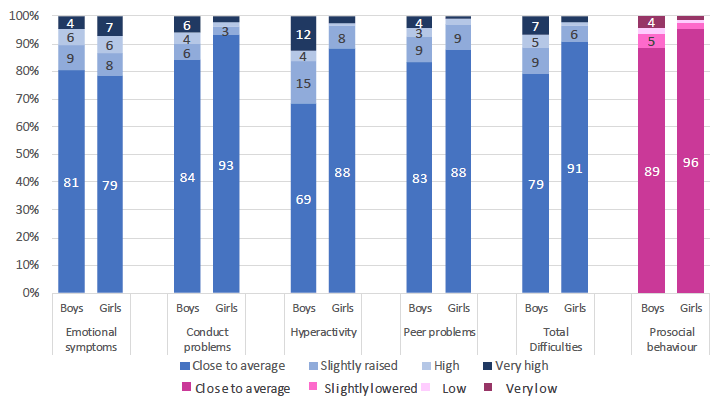
Base: All children (keyworker observations, weighted)
Differences in SDQ total difficulties score by socio-economic status
To avoid further repetition, the remaining analysis of the SDQ scales has been conducted for the total difficulties score only. As shown in Figure 15 and Tables C14 and C15 in Appendix C, a child's SDQ total difficulties score was also associated with a range of socio-economic factors. Children were more likely to have raised scores if they lived in low-income households (Figure 15). Around one-in-five (20-21%) of those in the two lowest income quintiles had raised / high scores, compared with one-in-ten (7-11%) of those living in higher income households. Similarly, children were more likely to have raised scores if their parent had no formal educational qualifications (Table C14) or if they lived in a single parent household (Table C15).
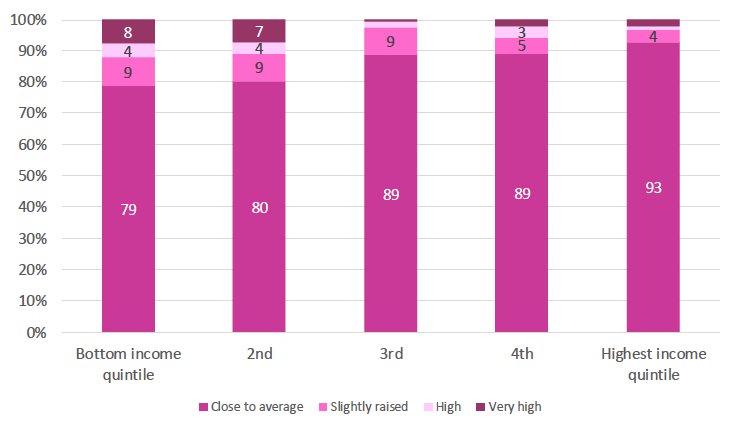
Base: All children (keyworker observations, weighted)
General health and long-term illnesses
Parents were asked to rank their child's general health as either 'very good', 'good', 'fair', 'bad' or 'very bad'. Three-quarters of parents (76%) ranked their child's health as being 'very good', and a further one-fifth (21%) ranked it as being 'good'. Only 2% of parents stated their child's health was 'fair' and fewer than 1% ranked it as being 'bad'.
There was no noticeable difference in perceptions of the child's general health for boys and girls. Nor was there a significant difference in perceptions of children's general health related to area deprivation. However, there was a difference in perceptions between single parent and couple parent households with 65% of those in single parent households perceiving their child's health as being 'very good' compared with 78% of those in couple households (see Table 5).
Table 5: Child's general health by household type
| Single parent | Couple parent | All | |
|---|---|---|---|
| % | % | % | |
| Very good | 65 | 78 | 76 |
| Good | 29 | 20 | 21 |
| Fair | 6 | 2 | 2 |
| Bad | - | 0 | 0 |
| Unweighted base | 274 | 1,096 | 1,380 |
Base: All respondents (parent survey, weighted)
One-in-ten children (10%) had a longstanding illness or health condition. Of these children, 15% of parents said that the longstanding illness limited the child 'a lot', 44% said it limited them 'a little' and 41% stated the longstanding illness did not limit their child, meaning that 6% of all four- and five-year-old children attending an ELC setting had a longstanding limiting illness. Boys were more likely to have a longstanding condition than girls (12% compared with 8%). There was also a difference by household type with 14% of children in single parent households having a longstanding illness compared with 9% of children in two parent households.
Longstanding illnesses were most commonly associated with mental health, social, emotional or behavioural issues (30% of those with a long-term condition). However, one quarter of those whose child had a longstanding illness stated it affected the child's stamina or breathing and just over one-fifth (22%) said it affected the child's learning, concentrating or remembering. Table 6 provides a complete summary of these responses. Seventy-one percent of the parents of children with a long-term condition mentioned that it affected their child in just one of the ways listed in Table 6, while 21% mentioned two different ways and 8% three or more.
| All | |
|---|---|
| % | |
| Vision | 13 |
| Hearing | 11 |
| Mobility | 10 |
| Learning, concentrating or remembering | 22 |
| Stamina or breathing difficulty | 25 |
| Mental health, social, emotional or behavioural issues | 30 |
| Other impairment(s) | 30 |
| Unweighted base | 128 |
Base: All children with a long-term condition (parent survey, weighted)
*Note: respondents were able to choose more than one response. As such, percentages will not total 100%.
Parents were asked whether they had any concerns about how their child talks or how they understand. The majority of parents had no concerns about either (86% and 96% respectively). There were some differences between boys and girls, as shown in Figure 16. For girls, 99% of parents had no concerns about how they understood, compared with 93% of parents of boys. Seventeen percent of parents of boys had concerns about how their child talks compared with 11% of parents of girls. There were no significant differences in responses between single and couple parent households, nor was area deprivation a significant factor.
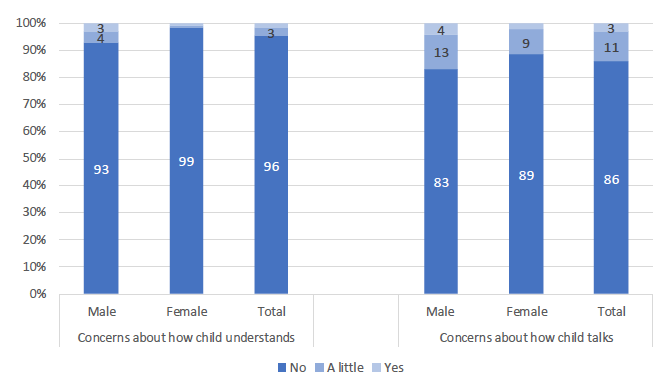
Base: All respondents (parent survey, weighted)
Home environment
Parents were asked for a range of information capturing aspects of their child's early childhood circumstances, experiences and behaviours which are known to be associated with child development. These include sleep patterns, breastfeeding, and activities at home that promote learning. Once we have explored these in more detail, we shall return to the assessments of development to examine the relationships between ASQ and SDQ scores and the child's home environment.
Six-in-ten children aged four or five (60%) slept through the night every night (Table 7). There were no significant differences in this measure according to sex of the child, area deprivation or household type.
| All | |
|---|---|
| % | |
| Never sleeps right through the night | 6 |
| 1-2 times a week | 7 |
| 3-5 times a week | 13 |
| 6 times a week | 14 |
| Every night | 60 |
| Unweighted base | 1,374 |
Base: All respondents (parent survey, weighted)
Just over half (55%) of children had ever been breastfed, with no significant differences between boys and girls. There were differences in incidences of breastfeeding related to area deprivation and household type, summarised in Figure 17. Only one-third (34%) of children who lived in the most deprived areas had ever been breastfed, compared to more than two-thirds (70-71%) in the two least deprived quintiles. There was also a lower rate of breastfeeding among single parents than couple parents: 37% of single parents reported that their child was ever breastfed, compared with 59% of those living in two-parent households.
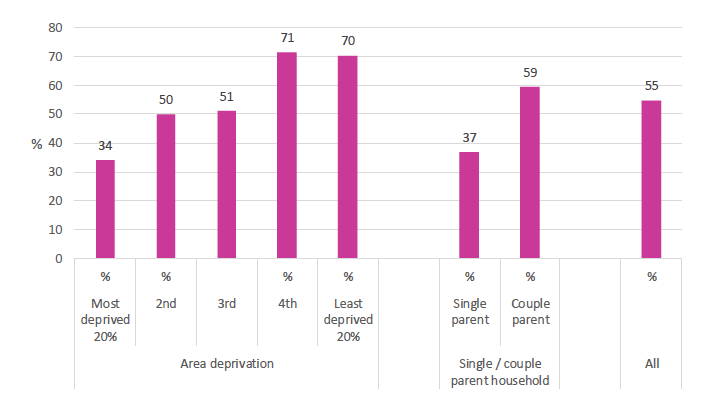
Base: All respondents (parent survey, weighted)
Parents were asked how often the child had been engaged in various home learning activities in the previous seven days. These included looking at books / reading stories, painting or drawing, reciting nursery rhymes / singing songs and playing at recognising letters, words, numbers or shapes.
The most common activity was looking at books or reading stories which 57% of children had done every day in the previous week. Reciting nursery rhymes / singing songs and recognising letters, words, numbers and shapes were also relatively common activities with 51% of children having done the former every day in the last seven and 42% the latter. Painting and drawing was less common, with a quarter (25%) of children having done this every day. Thirteen percent of children had done all four of the activities on every day in the previous week, while very few (< 0.5%) had done none of the activities at all over that time.
There were some differences in activities engaged in between girls and boys, between those in single and couple parent households, and according to area deprivation, as shown in Table 8. Boys were less likely to have been engaged in activities related to painting and drawing than girls - 16% of boys having done this each day in the last seven compared with 34% of girls. Boys also sang songs / recited nursery rhymes less frequently (45% of boys did this every day compared with 58% of girls). Children in single parent households were less likely to have looked at books and read stories than children in couple parent households. Thirty-nine percent of those in single parent households had read books / looked at stories every day in the last week compared with 61% of children in couple parent households. Those living in deprived areas were also less likely to have looked at books every day: 41% of children in the most deprived areas had done so, compared with 61% of children in other areas.
| Male child | Female child | Most deprived 20% | Other area | Single parent | Couple household | All | |
|---|---|---|---|---|---|---|---|
| % | % | % | % | % | % | % | |
| Looked at books or read stories | |||||||
| Not in last 7 days | 2 | 1 | 5 | 1 | 3 | 1 | 2 |
| 1 to 3 days | 16 | 14 | 23 | 13 | 29 | 12 | 15 |
| 4 to 6 days | 27 | 26 | 31 | 25 | 30 | 25 | 26 |
| 7 days | 55 | 58 | 41 | 61 | 39 | 61 | 57 |
| Painting or drawing | |||||||
| Not in last 7 days | 6 | 1 | 4 | 3 | 3 | 3 | 3 |
| 1 to 3 days | 45 | 23 | 34 | 35 | 36 | 34 | 34 |
| 4 to 6 days | 33 | 42 | 40 | 37 | 38 | 37 | 37 |
| 7 days | 16 | 34 | 22 | 25 | 22 | 26 | 25 |
| Recited nursery rhymes or sung songs | |||||||
| Not in last 7 days | 2 | 1 | 2 | 2 | 3 | 1 | 2 |
| 1 to 3 days | 21 | 13 | 17 | 17 | 17 | 17 | 17 |
| 4 to 6 days | 31 | 28 | 25 | 31 | 30 | 30 | 30 |
| 7 days | 45 | 58 | 57 | 50 | 50 | 52 | 51 |
| Recognising letters, words, numbers or shapes | |||||||
| Not in last 7 days | 2 | 2 | 3 | 2 | 5 | 1 | 2 |
| 1 to 3 days | 20 | 19 | 22 | 19 | 22 | 19 | 20 |
| 4 to 6 days | 35 | 38 | 37 | 36 | 33 | 38 | 36 |
| 7 days | 43 | 41 | 38 | 43 | 40 | 42 | 42 |
| Unweighted base* | 684 | 673 | 408 | 236 | 267 | 1,086 | 1,361 |
Base: All respondents (parent survey, weighted)
*Note: bases vary slightly for each individual activity. The bases shown are the lowest amongst the four activities.
The frequencies at which children had done each activity in the last seven days were summed together to create a total home learning activity score. The score ranged from 0 to 28 with the highest score indicating the child had been engaged in all four activities on each of the previous seven days. The cohort was then split into four evenly sized groups (quartiles) according to their scores on the scale: 0 to 16 (24% of all children); 17 to 21 (28%); 22 to 24 (23%) and 25 to 28 (26%).
Figure 18 breaks down the home learning environment (HLE) score quartiles by the parent's highest educational qualification.
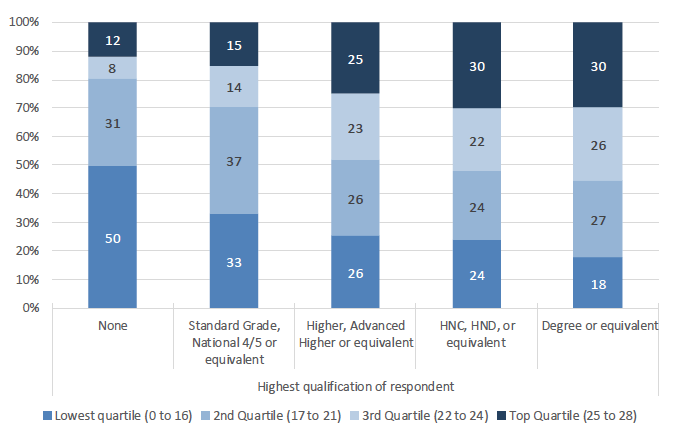
Base: All respondents (parent survey, weighted)
In general, the higher the educational qualification held by the parent, the more likely the child was to be in a higher HLE group. Half of those whose parents had no qualification were in the lowest quartile for HLE, representing the least frequent home learning activities, compared with 18% of those whose parents had a degree or equivalent. Only 12% of those children whose parents had no qualifications were in the top quartile for HLE, compared with 30% of those with post-school qualifications (HNC, HND, degree or equivalent).
Parents were also asked about how chaotic or ordered their home was using four items taken from the Confusion, Hubbub and Order Scale (CHAOS)[31]. The items ask parents how much they agree or disagree with four statements:
- It's really disorganised in our home
- You can't really hear yourself think in our home
- The atmosphere in our home is calm
- First thing in the day, we have a regular routine at home
Responses to these questions are summarised in Figure 19.
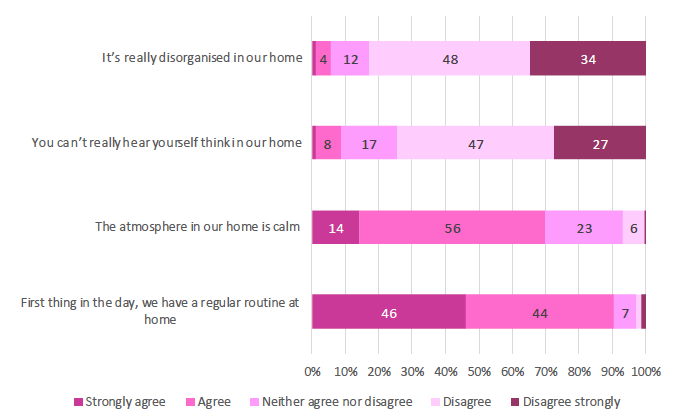
Base: All respondents (parent survey, weighted)
Most parents disagreed with the first two statements and agreed with the last two, indicating that their homes were calm and organised. Overall, 91% agreed that they had a regular routine first thing in the day, 70% agreed that the atmosphere in their home was calm, 74% disagreed that they could not really hear themselves think in their home and 83% disagreed that it was really disorganised in their home. There was no significant variation in responses to any of these statements by sex of the child, area deprivation or by household type.
Responses to these four statements were summed together - reversing the last two items - to create a scale with possible values from 4 to 20, with higher values representing more chaotic households. The scale was then divided into three groups of equal size indicating households with low, moderate and high levels of chaos. This scale was used earlier as a predictor of ASQ and SDQ scores. There was no significant variation in this scale according to sex, area deprivation, household type, parental education or income.
Assessments of development and home environment
The ASQ domains and the SDQ total difficulties score were examined in relation to a number of risk factors or family attributes (see the sections on developmental risk factors, parental outcomes and characteristics of the cohort for more details of these measures). In this section we look first at the associations between individual risk factors and child development outcomes, and then use logistic regression analysis to identify the key drivers of development outcomes.
ASQ communication domain
For most of the factors examined relating to the child's home environment, there were no significant differences between subgroups in the proportion of children assessed as on schedule in the ASQ communication domain. This was true for differences in parental long-term conditions, parental mental wellbeing, home learning environment, the "confusion, hubbub and order" scale, parental self-efficacy, and whether the child was ever breastfed. The only further factor examined where there was a difference on the ASQ communication domain was whether the child sleeps through the night (see Figure 20). In general, children aged four or five who slept through the night every night or most nights were more likely to be assessed as on schedule (89-94%) than those who slept through the night no more than two nights a week (80-84%).
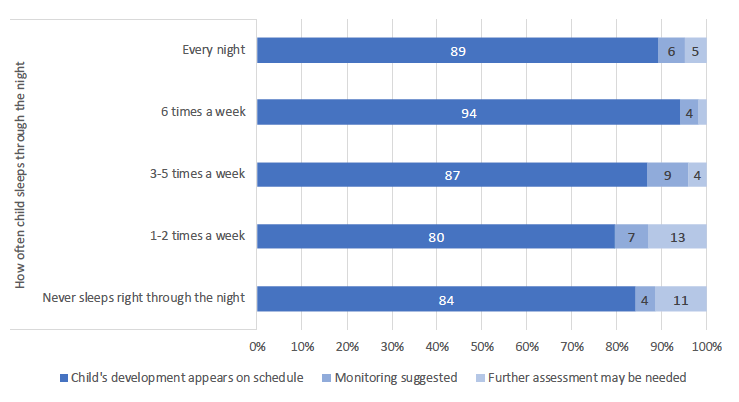
Base: All children (with responses to both parent questionnaire and keyworker observations, weighted)
ASQ gross motor domain
Scores on the gross motor domain did not appear to be strongly associated with any of the family attributes discussed in relation to the communication domain above, suggesting that it may not be easy to improve scores on the gross motor domain through modifying parenting behaviours or the child's home life.
ASQ fine motor domain
As we have already seen, the ASQ fine motor domain was strongly associated with socio-economic status. It was also associated with many of the other risk factors that were examined that are potentially modifiable at a population level, if not an individual level. Sleeping through the night at least once a week (compared with never sleeping through the night) was associated with a child's development being deemed on schedule (Appendix Table C16). Children whose parents reported that they were coping well as a parent most or all of the time were more likely to be on schedule than those whose parents reported this was true less often and those who lived in the least chaotic homes, according to the shortened form of the confusion, hubbub and order scale (described in the section above) were more likely to be assessed as having their development on schedule (Appendix Tables C17 and C18).
Figure 21 demonstrates the relationship between the ASQ fine motor domain scores and three further risk factors, the child's home learning environment (HLE), whether the child was ever breastfed, and parental mental wellbeing. The home learning environment is a measure of the frequency of certain learning activities, such as looking at books or reciting rhymes or songs done by the child with someone in their home environment. The proportion of children assessed as having fine motor development on schedule increased in line with an increase in the frequency of home learning activities, from 76% of children in the bottom quartile (i.e. those who did learning activities at home least frequently) to 88% of those in the top quartile. Children who had ever been breastfed by their mother were also more likely to be on schedule for development than those who had not (87% and 78% respectively). In addition, children of parents with low mental wellbeing were less likely than those of parents with average or above average mental wellbeing to be on schedule (74% compared with 84%).
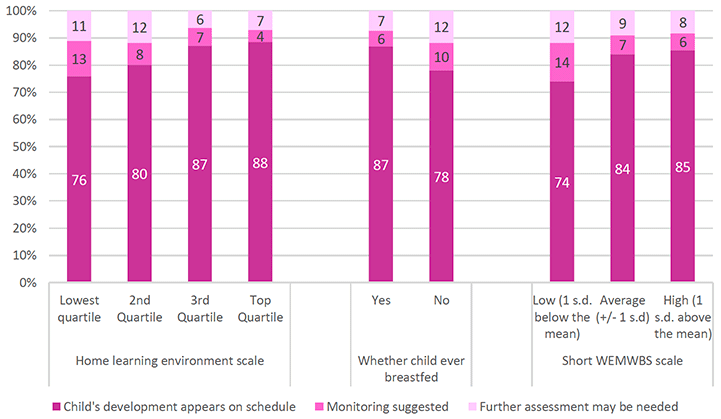
Base: All children (with responses to both parent questionnaire and keyworker observations, weighted)
ASQ problem solving domain
Figure 22 shows two associations between risk factors relating to the child's home life and scores on the ASQ problem solving domain. The proportion of children assessed as having their problem solving development on schedule increased from 85% among those who participated in home learning activities least frequently to 95% of those who participated in them most frequently. In addition, a higher proportion of those who were ever breastfed (94%) were on schedule than those who were never breastfed (85%).
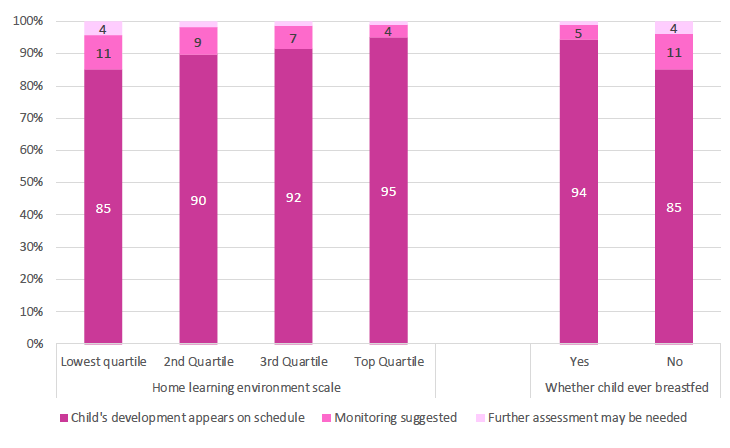
Base: All children (with responses to both parent questionnaire and keyworker observations, weighted)
ASQ personal-social domain
While ASQ personal-social scores had shown little association with socio-economic factors, they were associated with two factors related to the child's home life: the frequency with which the child slept through the night, and the frequency of home learning activities (Figure 23). Children who slept through the night more often were more likely to be on schedule than those who did so less often – 85% of those who never slept through the night were on schedule compared with 94-99% of those who slept right through at least three nights a week. As seen in relation to other domains, children who were engaged less frequently in home learning activities were also less likely than those who were engaged more frequently to be assessed as on schedule (91% of those in the lowest quartile compared with 96-97% in the top two quartiles).
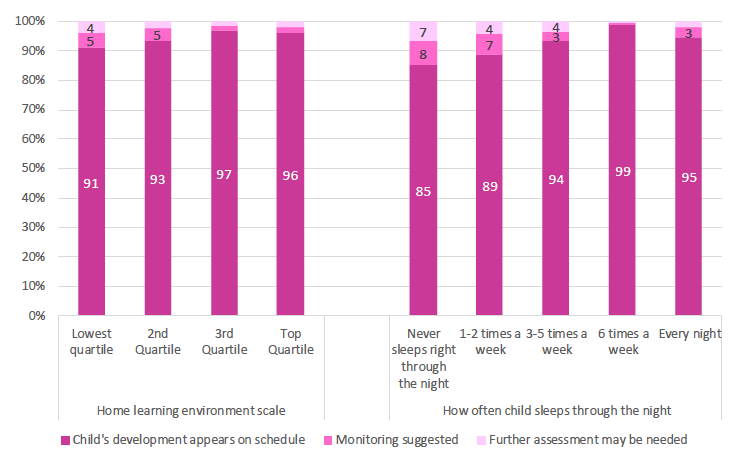
Base: All children (with responses to both parent questionnaire and keyworker observations, weighted)
SDQ total difficulties score
Children were more likely to have raised scores on the SDQ total difficulties scale if their parent had a longstanding physical or mental health condition (Table C19 in Appendix C), if they were in the lowest quartile for frequency of home learning activities (Table C20), or if they were never breastfed (Table C21).
Figures 24 and 25 show four associations with a child's total difficulties score where the direction of causality is not at all clear, and may indeed be circular. Where parents felt that they were coping well most or all of the time, 89% of children had close to average total difficulties scores whilst where parents felt they were coping well less often, 76% of children had close to average scores. Of children who slept through the night most or every night, 88-89% had close to average scores compared with 74% of children who never slept through the night. Children who lived in the least chaotic homes (according to the shortened version of the confusion, hubbub and order scale) were more likely to have close to average scores on the total difficulties scale than those in the most chaotic homes (90% compared with 81%). Where parents had below average mental wellbeing (according to the shortened form of the WEMWBS scale, 70% of children were close to average on the total difficulties scale, compared with 86-89% of children of parents with average or above mental wellbeing.
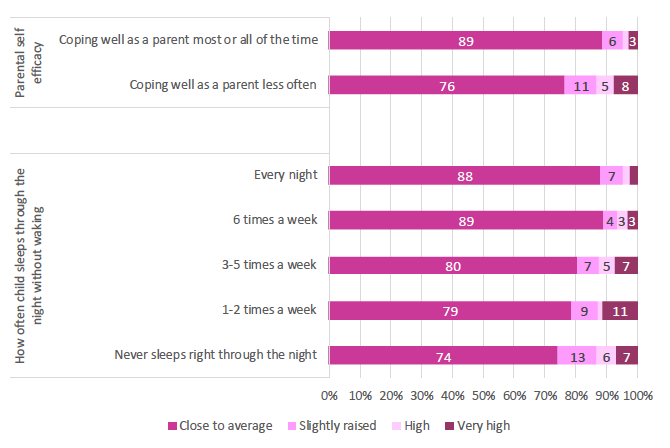
Base: All children (with responses to both parent questionnaire and keyworker observations, weighted)
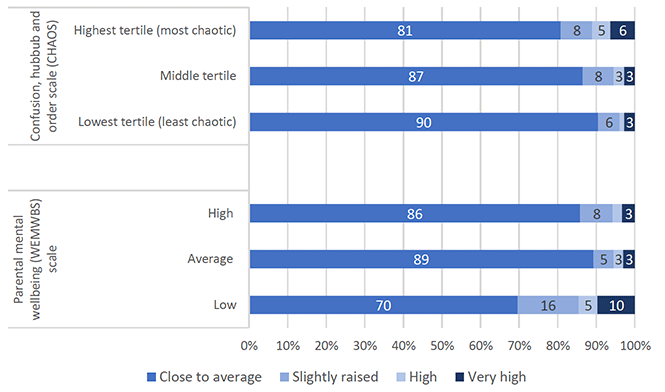
Base: All children (with responses to both parent questionnaire and keyworker observations, weighted)
Key drivers of delayed development (using Ages and Stages Questionnaire)
Many of the factors we have looked at so far are associated with each other as well as with scores on the ASQ domains. For example, home learning activities are more common in households where the mother has higher levels of education. The same is true for breastfeeding. Hence there is an association between breastfeeding and the home learning environment, albeit an indirect one. This makes it difficult to identify whether it is the home learning environment, the breastfeeding, or the parental education that drives the child's development. Logistic regression analysis allows us to model scores on the ASQ scales, looking at multiple factors simultaneously. It can identify the strongest associations with the ASQ scores, which can generally be interpreted as the key drivers, as well as those which appear to be associated only because of relationships with other variables.
Table 9 shows the results of the regression analysis. Full details of the analysis are shown in Appendix D, together with information on how to read the tables. While controlling other factors, we can see that boys were more likely than girls to demonstrate delayed development on at least two domains of the ASQ. It should still be emphasised that, as seen earlier, on each the domains the vast majority of boys were on schedule, but the proportion of boys not on schedule was higher than the proportion of girls.
Children with a long-term health condition or disability were also significantly more likely to demonstrate delayed development after controlling other factors. This is not surprising, given that such conditions were identified in either the keyworker questionnaire in terms of their potential for delaying development, or in the parent questionnaire as lasting, or expected to last for 12 months or more.
The next most significant factor in driving delayed development was having a parent with low levels of education. Two further factors included in Table 9 were statistically significant: being from a larger family of at least three children and not using English as the main or only language at home.
A number of other factors were included in the full model (see Table D1 in Appendix D). None of these showed independent significant associations with delayed development on two or more of the ASQ domains. This indicates that the differences we have observed earlier in terms of area deprivation and the number of parents in a household can, at least in part, be explained through those variables included in Table 9. Thus living in a deprived area and being from a single parent household are not in themselves drivers of delayed development, but some of the factors associated with them, such as lower levels of parental education, are drivers of delayed development.
| Significance | |
|---|---|
| Male | +++ |
| Long-term health condition | +++ |
| Two or more siblings | ++ |
| English not main / only language | ++ |
| Parent has no / lower school qualifications only | +++ |
| Unweighted base | 1,301 |
Base: All respondents (with responses to both parent questionnaire and keyworker observations, weighted)
+++ highly significant, ++ moderately significant, + marginally significant
Key drivers of raised levels of total difficulties (using Strengths and Difficulties Questionnaire)
The same type of analysis was conducted for raised / high scores on the the total difficulties scale of the Strengths and Difficulties Questionnaire. Full details of the model are included in Table D2 of Appendix D, with the key drivers highlighted in Table 10.
As with the previous model, both being a boy and having a long-term illness or health condition show strong associations with raised or high scores on the SDQ total difficulties scale, once other factors are controlled. In this model, having a parent with low mental wellbeing is also strongly associated with raised or high levels of difficulties. The direction of this association, however, cannot be identified from the model. Parents with low mental wellbeing may find parenting more difficult, with knock-on effects for the child's social, emotional and behavioural development. At the same time, parents may find children whose development is delayed stressful, which affects their own mental wellbeing. In reality it is likely that the association goes both ways, suggesting a need to look at family wellbeing, as well as the individual wellbeing of both parents and children.
In this model none of the other predictors, such as area deprivation and number of parents, showed significant associations with raised or high scores on the total difficulties scale when controlling other factors.
| Significance | |
|---|---|
| Male | +++ |
| Long-term health condition | +++ |
| Parent has low mental wellbeing | +++ |
| Unweighted base | 1,313 |
Base: All respondents (with responses to both parent questionnaire and keyworker observations, weighted
+++ highly significant, ++ moderately significant, + marginally significant
Contact
Email: socialresearch@gov.scot
There is a problem
Thanks for your feedback